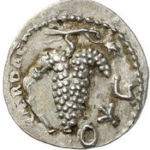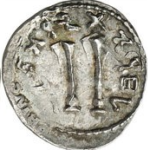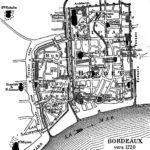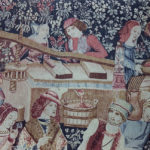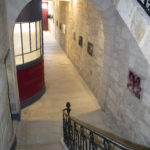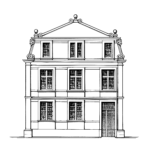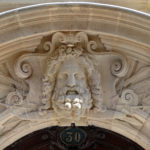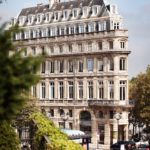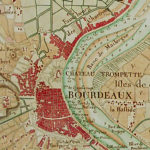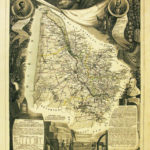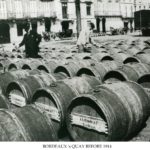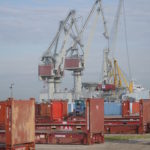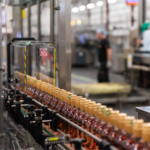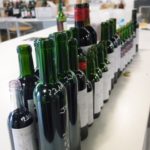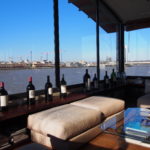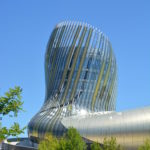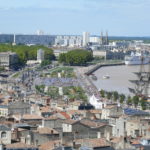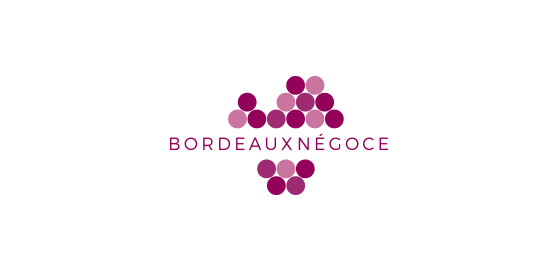-
1st century
It all begins with a grape variety
The proliferation of vines planted around Bordeaux begins by the discovery of a grape variety capable of withstanding harsh winters, the Biturica, source of a first period of prosperity under Roman occupation, which establishes “Pax Romana” and assists the progress of trade. The local economy benefits from Rome’s passion for the very first Bordeaux wines, extolled by the poet Ausone. Gallo-Roman villas are surrounded by vines. The winegrowing area invades the suburbs of Burdigala and the “slopes” of the right bank.
Following the fall of the Roman Empire (476), five centuries of invasions almost wiped out Bordeaux’s winegrowing region. But we can thank monks for saving the Biturica’s gene pool by maintaining a few plots of vines around churches and abbeys.
- Amphorae
- Roman coin with grapes
- Roman coin
-
12th century
Bordeaux, so British
Bordeaux begins to regain its splendour of ancient times with the lineage of Williams, Dukes of Aquitaine. Eleanor of Aquitaine profoundly disrupts alliances by her second marriage to Henry II, Duke of Anjou, given firstly the title of Duke of Normandy and then crowned King of England in 1154.
This is the period of profitable trade: English cloth is traded for Bordeaux wines. Bordeaux merchants are exempt from taxes by the King. These royal privileges make it possible to supply England abundantly in “Claret”, a very popular wine among Anglo-Saxons (a kind of dark rosé, the forerunner of red Bordeaux). Twice a year, before Christmas and Easter, an actual fleet of wine ships that can include as many as 200 vessels, sets sail from England to “go to fetch wine” in exchange for fabrics, foodstuffs and metals. In this way, Bordeaux establishes a monopoly of production, sale and distribution to Great Britain. Vines gain ground and invade the surrounding areas of Fronsac, Saint-Emilion, Cadillac, Barsac, Langon… Aquitaine remains an English province for 3 centuries and shows flourishing prosperity.
- Port of Bordeaux in 1220
- Medieval harvest 12th century
- Recumbent figure of Eleanor of Aquitaine
-
15th century
The end of the golden age, wine merchants settle in the Chartrons district
This extraordinary trade flow comes to an abrupt halt with the savage, brutal Hundred Years War, which sets France in conflict with England. In 1453, the outcome of the Battle of Castillon hands Aquitaine back to France and Bordeaux is suddenly deprived of this trade outlet to England. It is not until the reign of Louis XI that the wine trade resumes and ‘foreigners’ may come to Bordeaux again. A district outside the city is granted to them: it is called the Chartreux (Carthusian) district (Chartrons). International wine trade is dealt with by this community, thanks to their fleet of vessels which will take precedence for almost 2 centuries.
- Map of Bordeaux in the 16th century
- Quays of Bordeaux in the 15th century
-
17th century
Long live Holland!
With more political and economic stability, business picks up again in Bordeaux, with the emergence of a new clientele comprised of Dutch, Hanseatic and Breton customers.
The Dutch introduce sales procedures that are quite different to those of their English predecessors, with the development of eau-de-vie.
Bordeaux winegrowers therefore start to supply them, in addition to traditional Clarets, with dry white and semi-sweet white wines intended for distillation.
Excellent traders and buyers, the Dutch gear their production towards fine wines, such as the legendary “Ho-Bryan”, future Haut-Brion. They also bring numerous innovations, such as sterilisation of barrels using sulphur, to make it easier to preserve and transport wines. They establish themselves in the Chartrons district, a stone’s throw from the quays. Wines are exported in casks, handled on the quays of the city and stored in this district of wine merchants where, even nowadays, wine storehouses and export companies continue to exist.
- Main staircase Maison Sichel
- HMS Dutch Trading House
- Mascaron
-
18th century
The century of Enlightenment, Bordeaux is France’s largest port
During the 18th century, the Islands of America, Santo Domingo and the Caribbean isles, ensure the development of Bordeaux wine exports. At this time, Bordeaux has a fleet of ships inherited from Colbert and via this colonial trading, enjoys extraordinary prosperity, becoming France’s leading port.
Meanwhile, England represents just 10% of all Bordeaux wine exports. Greatly sought-after by London’s “High Society”, Bordeaux’s fine wines gain renown and distinction here. While in Bordeaux, Thomas Jefferson, future President of the United States of America, mentions a classification of wines drawn up by wine brokers and merchants. The concept of growths gains ground. At this time, the first corked and sealed bottles make their appearance, gradually replacing wooden casks for transportation.
The architecture of the city and its quays clearly show its wealth. Bordeaux orders the construction of the most extensive collection of buildings of the 18th century in Europe. Today, we can still marvel at the magnificent classical style of these edifices built with golden stone. This period of prosperity will last up until the French Revolution in 1789.
- Le Gobineau end of construction in 1789
- Treaty 1789 – Maison Schröder & Schyler
- Map of Bordeaux – 18th century
-
19th century
Prosperity and afflictions
At the turn of the century, a new golden age begins. Within a few decades, wine production increases twofold and exports triple. Exporters swarm to Northern Europe and the English once again become the key buyers. The industrial revolution and wine merchants’ free-trading mindset contribute largely to this new era of prosperity. It is combined with increased efforts to obtain fine quality, which becomes a reality with the renowned 1855 Classification, requested by Napoleon III at the occasion of the Universal Exhibition.
But trading, particularly with the United States, does not bring only positive aspects. It encourages the spread of vine diseases and parasites:
- powdery mildew is controlled by the invention of treatments made with sulphur (1857),
- phylloxera destroys the winegrowing region, between 1875 and 1892, but it is eventually saved by a system of grafting Bordeaux grape varieties onto American rootstocks that are resistant to this disease,
- mildew is treated with “Bordeaux mixture”, a preparation made with copper and invented to help vines be resistant to this new disease, imported from the United States. It is still used today, all around the world.
- Map of Gironde in 19th century
- Allées de Tourny
-
20th century
Under the banner of quality
Once diseases are controlled, the rapid development of vine growing coincides with a drop in price. Several major events contribute to this fall in price: the First World War, the Russian Revolution, Prohibition in the United States…
At the end of the 14-18 war, to resolve these difficulties, winegrowers and wine merchants establish the Union de la Propriété et du Commerce, an association grouping together leading figures of trade and viticulture. These are the early stages of an interprofessional organisation that endows itself with an effective, specialist organisation, the Comité Interprofessionnel d’Entente et d’Etude du Vin de Bordeaux, founded by the regional administration in 1943.
Wanting to enhance its products by ensuring better quality, the Bordeaux wine industry participates actively in the creation of the INAO (National Institute of Appellations of Origin) in 1936.
Nowadays, 97% of Bordeaux wine production is sold as an AOC, with its well-known success. This quest to ensure fine quality is also shown by the classification of Saint-Emilion wines, established in 1955, that of Graves wines in 1959 or the creation of the new AOC Pessac-Léognan in 1987.
The 20th century is also one of rapid adjustment to the modern world:
- Change of logistical constraints: orders are dispatched in bottles and less in bulk,
- Reduction of the number of companies: decreasing from 1 000 to 300 firms,
- Specificity of professions: wine merchants specialise according to products and markets, particularly to keep up with the development of distribution networks (emergence of the Large Retail sector, for example).
The impetus of winning back markets during the 1980s and 1990s boosts exports, which now represent 37% of sales. The end of the century marks the remarkable progress of technical expertise in agronomy, viticulture and oenology. It is also the period when foreign competitors come centre-stage (Californian, Australian, South African, etc…), which forces Bordeaux to reconsider its position, while “winning back” lost market share.
- Bordeaux’s quays before 1914
- Account book
- Trade documents and the Guide published by Féret
- Bordeaux trade port
-
21st century
The challenge: a new position in world supply
The world is in motion, changes are increasingly recurrent, ever more rapid and more frequently severe. Faced with these extreme situations, Bordeaux Wine Trade companies must be very flexible in order to adjust and integrate the skills and professions necessary for ensuring supply to more than 170 countries on export markets.
Procedures for corporate social responsibility (CSR) undertaken within Bordeaux Wine Trade firms are essential responses to these changes, which must be endured and are totally unpredictable: being attentive to their stakeholders, committing to improving the way environmental issues and sustainable development are taken into account, integrating into the Gironde region to maintain and guarantee activities of industrial production here…
These are all assets and strong points to start winning back our traditional markets, conquer some new ones, while satisfying the various demands of Bordeaux wine consumers.
- Bottling line
- Tasting of wine samples
- Wine analysis laboratory
- View of the left bank
- La Cité du Vin
- View of Bordeaux



